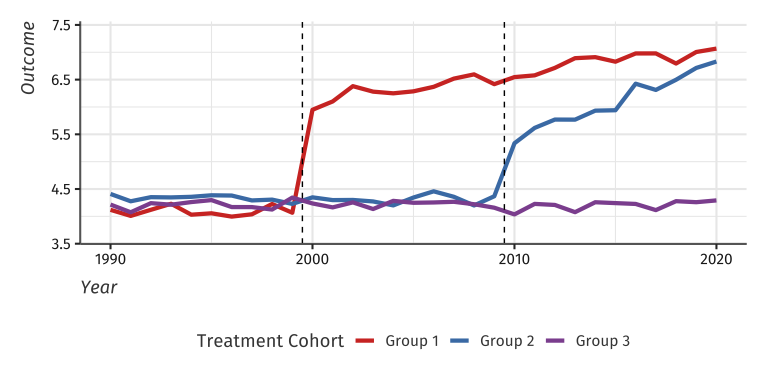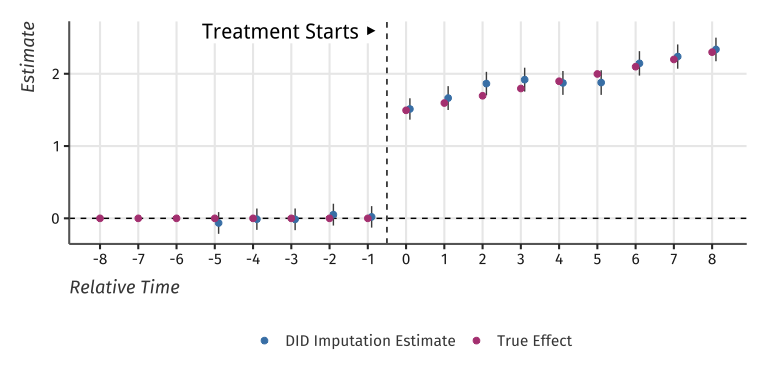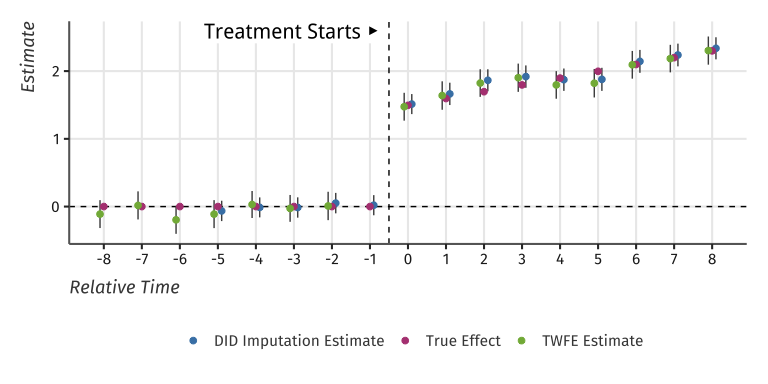
Example data with heterogeneous treatment effects
The goal of didimputation is to estimate TWFE models without running into the problem of staggered treatment adoption.
You can install didimputation from github with:
devtools::install_github("kylebutts/didimputation")I will load example data from the package and plot the average outcome among the groups. Here is one unit’s data:
library(tidyverse)
#> ── Attaching packages ─────────────────────────────────────── tidyverse 1.3.1 ──
#> ✓ ggplot2 3.3.5 ✓ purrr 0.3.4
#> ✓ tibble 3.1.3 ✓ dplyr 1.0.7
#> ✓ tidyr 1.1.3 ✓ stringr 1.4.0
#> ✓ readr 2.0.0 ✓ forcats 0.5.1
#> ── Conflicts ────────────────────────────────────────── tidyverse_conflicts() ──
#> x dplyr::filter() masks stats::filter()
#> x dplyr::lag() masks stats::lag()
library(didimputation)
#> Loading required package: fixest
#> From fixest 0.9.0 onward, BREAKING changes! (Permanently remove this message with fixest_startup_msg(FALSE).)
#> - In i():
#> + the first two arguments have been swapped! Now it's i(factor_var, continuous_var) for interactions.
#> + argument 'drop' has been removed (put everything in 'ref' now).
#> - In feglm():
#> + the default family becomes 'gaussian' to be in line with glm(). Hence, for Poisson estimations, please use fepois() instead.
library(fixest)
# Load theme
source("https://raw.githubusercontent.com/kylebutts/templates/master/ggplot_theme/theme_kyle.R")
#> Loading required package: showtext
#> Loading required package: sysfonts
#> Loading required package: showtextdb
# Load Data from did2s package
data("df_het", package="did2s")Here is a plot of the average outcome variable for each of the groups:
# Plot Data
df_avg <- df_het %>%
group_by(group, year) %>%
summarize(dep_var = mean(dep_var), .groups = 'drop')
# Get treatment years for plotting
gs <- df_het %>%
filter(treat == TRUE) %>%
pull(g) %>% unique()
ggplot() +
geom_line(data = df_avg, mapping = aes(y = dep_var, x = year, color = group), size = 1.5) +
geom_vline(xintercept = gs - 0.5, linetype = "dashed") +
theme_kyle(base_size = 16) +
theme(legend.position = "bottom") +
labs(y = "Outcome", x = "Year", color = "Treatment Cohort") +
scale_y_continuous(expand = expansion(add = .5)) +
scale_color_manual(values = c("Group 1" = "#d2382c", "Group 2" = "#497eb3", "Group 3" = "#8e549f")) 
Example data with heterogeneous treatment effects
First, lets estimate a static did:
# Static
static <- did_imputation(data = df_het, yname = "dep_var", gname = "g", tname = "year", idname = "unit")
static
#> # A tibble: 1 × 5
#> term estimate std.error conf.low conf.high
#> <chr> <dbl> <dbl> <dbl> <dbl>
#> 1 treat 2.26 0.0314 2.20 2.32This is very close to the true treatment effect of 2.2384912.
Then, let’s estimate an event study did:
# Event Study
es <- did_imputation(data = df_het, yname = "dep_var", gname = "g",
tname = "year", idname = "unit",
# event-study
horizon=TRUE, pretrends = -5:-1)
es
#> # A tibble: 26 × 5
#> term estimate std.error conf.low conf.high
#> <chr> <dbl> <dbl> <dbl> <dbl>
#> 1 -5 -0.0641 0.0767 -0.214 0.0861
#> 2 -4 -0.0120 0.0753 -0.160 0.136
#> 3 -3 -0.0139 0.0765 -0.164 0.136
#> 4 -2 0.0510 0.0770 -0.0999 0.202
#> 5 -1 0.0202 0.0758 -0.128 0.169
#> 6 0 1.51 0.0755 1.37 1.66
#> 7 1 1.66 0.0841 1.50 1.83
#> 8 2 1.86 0.0829 1.70 2.03
#> 9 3 1.92 0.0843 1.75 2.08
#> 10 4 1.87 0.0842 1.71 2.04
#> # … with 16 more rowsAnd plot the results:
pts <- es %>%
select(rel_year = term, estimate, std.error) %>%
mutate(
ci_lower = estimate - 1.96 * std.error,
ci_upper = estimate + 1.96 * std.error,
group = "DID Imputation Estimate",
rel_year = as.numeric(rel_year)
) %>%
filter(rel_year >= -8 & rel_year <= 8) %>%
mutate(rel_year = rel_year + 0.1)
te_true <- df_het %>%
# Keep only treated units
filter(g > 0) %>%
group_by(rel_year) %>%
summarize(estimate = mean(te + te_dynamic)) %>%
mutate(group = "True Effect") %>%
filter(rel_year >= -8 & rel_year <= 8) %>%
mutate(rel_year = rel_year)
pts <- bind_rows(pts, te_true)
max_y <- max(pts$estimate)
ggplot() +
# 0 effect
geom_hline(yintercept = 0, linetype = "dashed") +
geom_vline(xintercept = -0.5, linetype = "dashed") +
# Confidence Intervals
geom_linerange(data = pts, mapping = aes(x = rel_year, ymin = ci_lower, ymax = ci_upper), color = "grey30") +
# Estimates
geom_point(data = pts, mapping = aes(x = rel_year, y = estimate, color = group), size = 2) +
# Label
geom_label(data = data.frame(x = -0.5 - 0.1, y = max_y + 0.25, label = "Treatment Starts ▶"), label.size=NA,
mapping = aes(x = x, y = y, label = label), size = 5.5, hjust = 1, fontface = 2, inherit.aes = FALSE) +
scale_x_continuous(breaks = -8:8, minor_breaks = NULL) +
scale_y_continuous(minor_breaks = NULL) +
scale_color_manual(values = c("DID Imputation Estimate" = "steelblue", "True Effect" = "#b44682")) +
labs(x = "Relative Time", y = "Estimate", color = NULL, title = NULL) +
theme_kyle(base_size = 16) +
theme(legend.position = "bottom")
#> Warning: Removed 17 rows containing missing values (geom_segment).
Event-study plot with example data
# TWFE
twfe <- fixest::feols(dep_var ~ i(rel_year, ref=c(-1, Inf)) | unit + year, data = df_het) %>%
broom::tidy() %>%
filter(str_detect(term, "rel_year::")) %>%
select(rel_year = term, estimate, std.error) %>%
mutate(
rel_year = as.numeric(str_remove(rel_year, "rel_year::")),
ci_lower = estimate - 1.96 * std.error,
ci_upper = estimate + 1.96 * std.error,
group = "TWFE Estimate"
) %>%
filter(rel_year <= 8 & rel_year >= -8) %>%
mutate(rel_year = rel_year - 0.1)
# Add TWFE Points
both_pts <- pts %>% mutate(
group = if_else(group == "Estimated Effect", "DID Imputation Estimate", group)
) %>%
bind_rows(., twfe)
ggplot() +
# 0 effect
geom_hline(yintercept = 0, linetype = "dashed") +
geom_vline(xintercept = -0.5, linetype = "dashed") +
# Confidence Intervals
geom_linerange(data = both_pts, mapping = aes(x = rel_year, ymin = ci_lower, ymax = ci_upper), color = "grey30") +
# Estimates
geom_point(data = both_pts, mapping = aes(x = rel_year, y = estimate, color = group), size = 2) +
# Label
geom_label(data = data.frame(x = -0.5 - 0.1, y = max_y + 0.25, label = "Treatment Starts ▶"), label.size=NA,
mapping = aes(x = x, y = y, label = label), size = 5.5, hjust = 1, fontface = 2, inherit.aes = FALSE) +
scale_x_continuous(breaks = -8:8, minor_breaks = NULL) +
scale_y_continuous(minor_breaks = NULL) +
scale_color_manual(values = c("DID Imputation Estimate" = "steelblue", "True Effect" = "#b44682", "TWFE Estimate" = "#82b446")) +
labs(x = "Relative Time", y = "Estimate", color = NULL, title = NULL) +
theme_kyle(base_size = 16) +
theme(legend.position = "bottom")
#> Warning: Removed 17 rows containing missing values (geom_segment).
TWFE and Two-Stage estimates of Event-Study